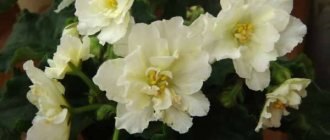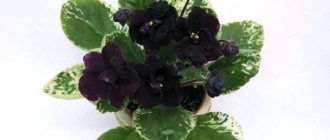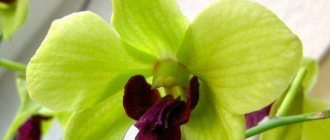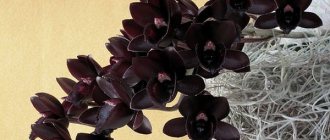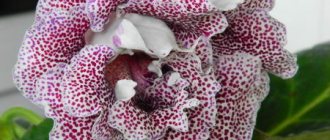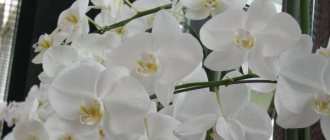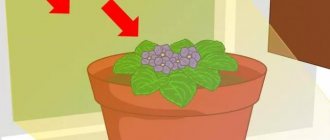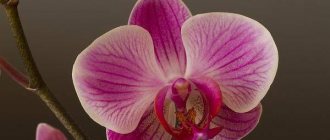Uzambara violet.
Family Gesneriaceae - Gesneriaceae.
Genus Saintpaulia hybrida - Hybrid Saintpaulia.
African violet saintpaulia hybrid.
Violets from breeders of the CIS countries - “Z” (RS).
RS -Green Lagoon (S. Repkina).
RS-Green Lagoon, RS-Zelenaya Laguna (S. Repkina).
Large, double, fringed white flowers with blue streaks and greenish outer petals.
Light green wavy foliage. Standard. It’s impossible to fight the rosette; it constantly lifts the leaves up, both on the windowsill and on the shelf. This is a varietal feature that cannot be corrected. But it’s still better to keep it on the windowsill.
Rose flowers with green and blue borders. If it’s hot, there’s not enough green, but there’s more blue, and vice versa when it’s cool. The flowers take a very long time to bloom, longer than usual, about two weeks. Such delicate heads of cabbage in a green shirt are captivating. Some never fully open, darken and dry out.
The first flowers are larger, then smaller. This variety has long peduncles. The flowers turn out very heavy. If the rosette becomes flat, the flower stalks would fall around and the bouquet would fall apart. And so - they are held in a bouquet, supported by leaves. Then the heavy flowers lie on the leaves and slightly straighten them.
It does not bloom very often, there are usually few flower stalks, 4-5 pieces, but due to the fact that the flowers are very large, the bouquet seems large. But the centers of the first flowers began to turn brown, dry out quickly, and they all don’t have time to bloom properly. The flowers do not open fully, and at some stage they begin to fade. The flowers are still in good condition, but the petals inside are starting to dry out, and it looks like old cabbage.
The variety is leisurely, grows slowly, blooms in 1.5-2 years. With age, it blooms darker and darker each time, so it has to be renewed. It turns out a dark lilac sport.
Lagoon (Italian lake) is a shallow body of water separated from the sea by a narrow strip of washed-up sand (bar) or coral reefs. Due to their protection, lagoons are often unique natural biotopes. They serve as a shelter for aquatic birds, fish and animals.
Do you know that…?
Variety - plant (French sorte, from Latin sors - variety, type), cultivator, a set of plants created as a result of selection and possessing certain morphological, physiological, economic characteristics and properties that are inherited; the lowest classification unit for cultivated plants. There are such rosettes on which both varietal and single-color flowers bloom at the same time, this is very attractive, but you need to know that this violet inevitably goes into sport.
Features of care
Violets prefer light, which plays a huge role during flowering. It is also not recommended to keep the plant in direct sunlight. Particular attention should be paid to watering the plant, since due to severe waterlogging of the soil, the roots begin to rot, as a result of which the violet dies. All violets need high humidity, but spraying is not recommended for this, as this procedure leads to the formation of spots on the leaves.
Violets are heat-loving indoor crops; they are best grown at air temperatures from 16 to 21 degrees above zero. Fertilizers are applied no more than once every 4 weeks.
Violet Green Lagoon: description of the variety and characteristics
The Green Lagoon violet variety was developed thanks to the work of breeder S. Repkin.
The rosette of the violet RS Green Lagoon is dense and of standard size, assembled from neat wavy leaves of light green color. Terry flowers, which in their shape resemble cabbage forks, are considered large; their size can exceed 6 centimeters in diameter.
The petals located on the outer edge of the flower have a greenish tint, while the base is white. Blue streaks are visible on the surface of the petals. The shades of flowers become darker with each flowering and if the plant is not rejuvenated, then after several years the flowers will acquire a dark purple color. Flowering in this species on E is frequent, but lasts for a long period of time.
The violet variety Green Lagoon, as a rule, grows from 4 to 5 flowering shoots, on which large flowers appear during flowering. Those that appear during the first flowering are larger in size than those that will appear in the future. The first flowering should be expected two years after the flower was planted. If the weather is hot outside, then blue shades will predominate; if it is cool, then green shades will prevail.
The Green Lagoon violet variety has an interesting feature: its leaves grow in an upward direction. They serve as support for heavy buds growing on weak flowering shoots, preventing the bouquet from falling apart.
Violet RS Green Lagoon is prone to diseases that lead to rotting of the rosette itself or drying out of the buds from the inside and they do not even have time to open.
Choosing soil and pot
To grow violets, use a small pot to prevent the root system from growing too large. Otherwise, the roots will take all the strength from the flower, and the violet will not bloom. Soil for indoor culture must be used ready-made, which can be purchased at any flower shop. However, experienced gardeners can prepare the soil mixture themselves, using coniferous, turf, peat or leaf soil, to which raising agents are added, for example, perlite, sand, chopped sphagnum moss, vermiculite. When planting a plant, it is imperative to put a layer of drainage on the bottom of the pot. For this you can use broken bricks, expanded clay, and pebbles.
Transfer
How to properly replant a violet? Please note that this plant is replanted at least once a year. The main reason is the reduction in leaf size due to the fact that the crop grows and becomes very crowded. As the violet grows, it forms new side rosettes, which should be separated from the main bush. Thanks to this, you can provide the plant with better flowering.
During transplantation, the bare part of the stem should not be more than 6 cm. In this case, the new pot is used one size larger than the old one.
Reproduction methods
There are several methods for propagating indoor violets. However, the leaf propagation method is most often used for this purpose. As a rule, it is carried out in summer and spring.
To do this, you need to choose a healthy leaf from a bush that is not damaged by diseases or insects. It is best to choose a sheet from the 3rd or 2nd row. You can separate the propagation leaf from the bush by cutting or breaking off. However, the cutting method would be more acceptable. Then the leaf is rooted. This procedure can also be carried out using several methods. To do this, the leaf can be placed in water for rooting, and also stuck into the ground. When it has roots, it should be transplanted to a permanent place in a separate pot.
Comments
Olya, there are no words, I froze for a moment, what a beauty. I’ll definitely start one too, I’ll write the name down in my diary right away.
- Login or register to post comments
It feels like painted rose buds have been tied to the violet leaves. Very beautiful, unusual! Wonderful variety! I'll definitely be looking for it in the catalog in the spring!
- Login or register to post comments
- Login or register to post comments
Olya, amazing beauty. What a combination of depth of color and shape! This is simply a miracle of selection. As soon as it appears in the catalog I will immediately order it.
- Login or register to post comments
Yes, but there are no words.
- Login or register to post comments
It looks like the variety has swam or sported. There's too much blue, it should be white.
Here is a description of the variety from Svetlana Repkina:
Flower: Large, double, fringed white flowers with blue streaks and greenish outer petals. Rosette: Light green wavy foliage.
- Login or register to post comments
I’m not sure yet that I’ve got the right variety! My leaves are dark. When I purchased this variety, the leaf was also dark. I will watch, but most likely sports.
- Login or register to post comments
Yes, Ol, this is a sport, unfortunately. I have the same. Mine has now budded and is getting ready to open. I was upset, it was already clear that he would not be white, but when I looked at yours, my mood noticeably improved. Very beautiful, like a rose!
- Login or register to post comments
Even if he sometimes floats, I still liked him. The shape of the flower is very interesting.
- Login or register to post comments
Girls, thank you all for your comments! I'm glad you liked the variety too!
- Login or register to post comments
Olya, even if it’s a sport, it’s great. Interesting flower shape. The rosette is neat.
But I still want the right variety. If you have several children from a leaf, then maybe one of them will flourish according to its variety. And it happens that the variety will show the second flowering. Good luck. .
- Login or register to post comments
The magnificence and diversity surprises and delights! And the blue roses are wonderful!
- Login or register to post comments
Olya, you can’t take your eyes off the rose! Gorgeous and so tender. It seems to me that both the variety and the sport are beautiful in their own way.
- Login or register to post comments
Olenka, in this case it doesn’t matter at all – the variety or the sport! In any case, this is just a dream for any violet lover. Amazing variety!
- Login or register to post comments
Olya, just a miracle! Even in blue version. I have had this variety on my wish list for a long time.
- Login or register to post comments
I wasn’t even upset that it didn’t bloom exactly as described, the main thing is the beauty, the shape of the flower! Of course I’d like to have a light version, I planted some leaves, I’ll see if the little ones come out bright! Thank you to all the girls for your comments and support!
- Login or register to post comments
Olga really liked the wonderful unusual flower
- Login or register to post comments
OOO! Why judge? Admire and only admire.
- Login or register to post comments
Well, very beautiful. Bravo.
- Login or register to post comments
And I want exactly this blue one. Will wait
- Login or register to post comments
Olya, I really liked it, it doesn’t matter what kind or sport it is. The flower shape is amazing.
- Login or register to post comments
lovely! The pumpkins of cabbage in the garden remind me
- Login or register to post comments
A wonderful flower! Real rose buds, but the color may change during the second flowering because the prerequisites are there
- Login or register to post comments
Today I wrote a letter to Svetlana Repkina, I wanted to know if the sports version already has a name, she replied that it doesn’t yet, but perhaps it will soon, because they give names to sports, such as EK-Grey Ocean, a variety from the sport EK-Black Pearl. Girls, thanks to everyone who joined the discussion of this variety!
Possible diseases and pests
Even if you follow all the features of violet care, insects and diseases can overtake it unexpectedly. The most common diseases among indoor Saintpaulias are the following:
- Rotting of the socket, the cause of which in most cases is waterlogging.
- Late blight. Violets suffer from late blight in most cases due to excess air humidity, as well as due to infrequent ventilation of the room.
- Gray rot. This disease develops, as a rule, at low indoor temperatures, below 16 degrees, and also with abundant watering.
Powdery mildew. Powdery mildew can be identified by the presence of small whitish spots that form on the upper side of the leaf. The reasons for the development of the disease are stagnant, humid air, as well as a sharp change in air temperature.
As for pests, most often this indoor crop is attacked by mealybugs, aphids, and spider mites. In most cases, this occurs due to the air being too dry or humid. Therefore, it is so important to monitor this indicator when growing violets at home.
Take into account
Before purchasing violets of the “green lagoon” variety, you need to carefully familiarize yourself with their breeding characteristics at home. Of course, in appearance they are quite beautiful flowers, but it is quite difficult for inexperienced gardeners to achieve abundant and lush flowering. Due to improper care, large rosettes with large and fragile leaves may form, with the foliage rising upward or hugging the pot, stepsons may also appear that will interfere with the formation of a proper rosette, the trunk may stretch upward and grow into a Christmas tree.
Many also often encounter rare flowering, which occurs with long intervals. In this case, the flowers stay on the bush for a short amount of time, wither quickly, and have recumbent or very long peduncles. Improper care can also cause the color to fade quickly, so you should not expose violets to direct sunlight on the windowsill. Also, these crops are afraid of the slightest waterlogging or drying out.
That is why, before purchasing a violet of the “green lagoon” variety, be sure to ask yourself whether you can provide proper care for this plant.
With proper care of your indoor plant, it will delight you with wonderful flowers, and flowering will occur frequently.
